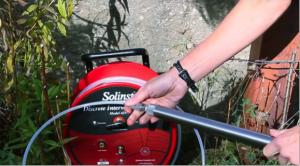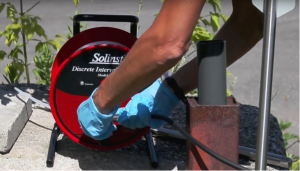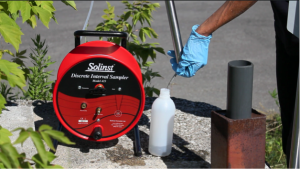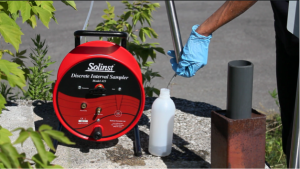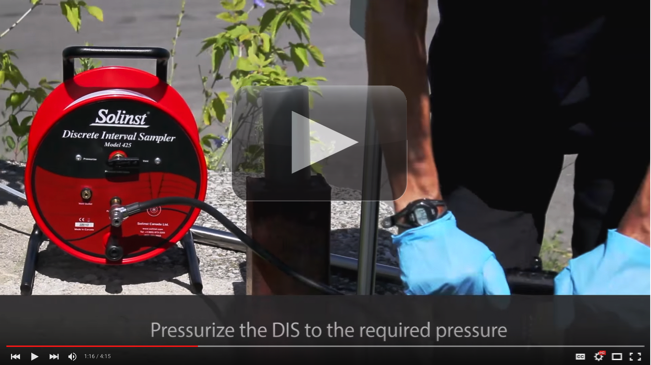What is a Discrete Interval Sampler?
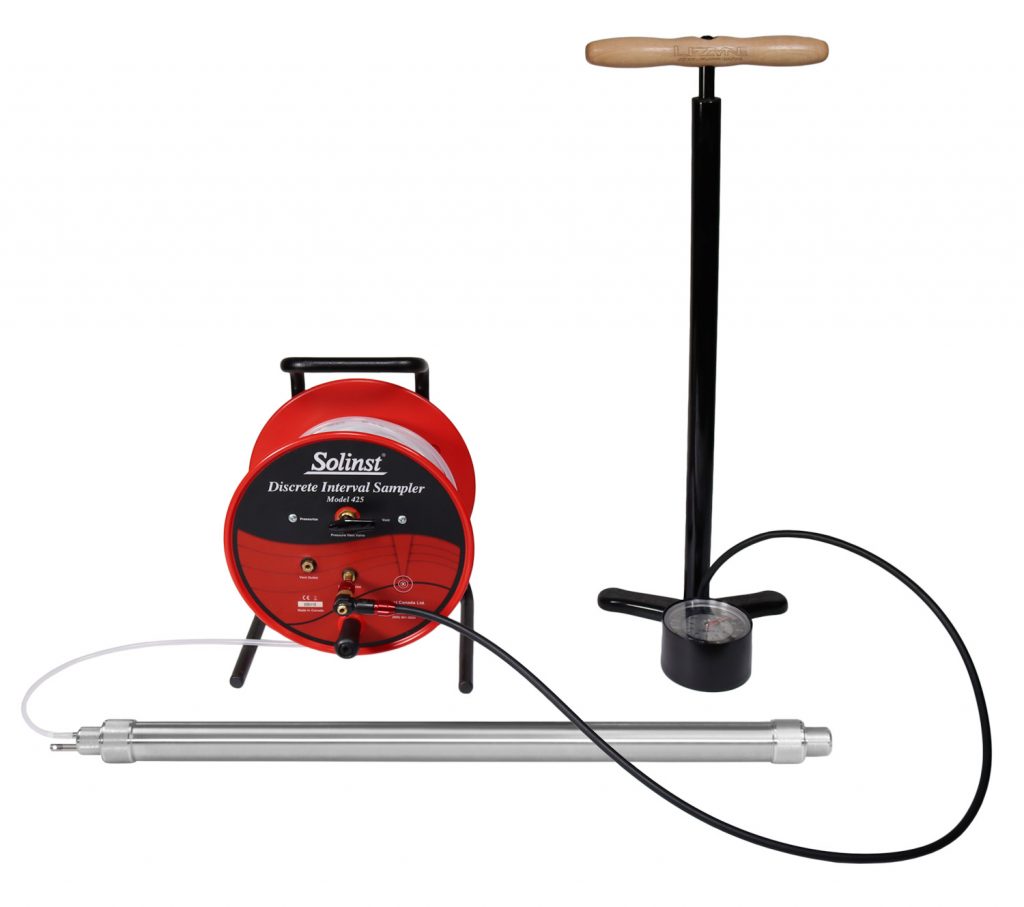
Solinst Model 425 Discrete Interval Sampler
The Solinst Model 425 Discrete Interval Sampler (DIS) is a “no purge” instrument, designed to obtain representative groundwater samples from a specific sampling zone without the need for purging. It is a stainless steel sampler pressure activated using a hand pump.
We’ll discus how it actually works later on…but first, what is a no purge sampler?
What is no purge sampling?
No purge sampling has become an increasingly accepted form of groundwater sampling, as it yields high quality results comparable to conventional purging and pumping techniques.
No purge or passive sampling methodology is based on the principle that groundwater naturally flowing through a screen and into a well, is representative of the groundwater outside the well at that same depth. Studies have shown that sampling at the screened interval should result in a high integrity sample, without the need for purging.
According to the U.S. EPA’s Contaminated Site Clean-Up Information (CLU-IN) website, there are three generic types of passive, no-purge samplers:
- Thief (grab) samplers
- Diffusion (equilibrium) samplers
- Integrating (kinetic)
Here, we will discuss a thief (grab) sampler.
In order to get a sample representative of aquifer conditions, no purge samplers must be submerged within the screened interval or open borehole, and remain in the well until groundwater conditions have re-stabilized. Once equilibrium is reached, a sample can be taken. Samples can also be taken as soon as the target depth is reached to obtain an instantaneous grab point sample.
When compared to conventional sampling methods, grab samplers typically require less cost and time to obtain a sample. Minimal labour is required as there is no purge water to worry about. Normally, no purge samplers do not require power, a compressor or control unit, and there is little or no well water disturbance when the samplers are deployed and operated.
However, you should consider a few things before choosing a no purge grab sampler for the job. Since passive sampling relies on the natural horizontal flow of groundwater through a screened interval in a well, you need to take into account any vertical flow in the well, contaminant stratification, hydraulic conductivity of the aquifer, mixing, etc. Other options, such as low flow sampling, should also be compared and considered to determine the most suitable sampling method.
How does the Discrete Interval Sampler work?
In short, the DIS is pressurized before being lowered into a well to prevent water from entering the sampler. Once the desired depth is reached, the pressure is released and hydrostatic pressure fills the sampler with water directly from the sampling zone. Once the sampler is filled, it is repressurized and raised to the surface.
However, let’s go over the major operating steps in more detail to get a much clearer idea of how a representative groundwater sample is obtained.
The steps below are based on operation of the 1.66″ diameter Discrete Interval Sampler:
1) The DIS is connected to a reel via LDPE or PTFE tubing; a convenient compression fitting at the top of the sampler is used for a secure connection. The reel supports the tubing and sampler and provides the pressure inlet for the hand pump and pressure/vent valve to regulate the pressure.
2) The hand pump is connected to the pressure inlet on the reel, and the valve on the reel is switched to “Pressurize”. The hand pump is used to apply pressure; a simple equation is used to determine how much pressure to apply.
Read the Discrete Interval Sampler Operating Instructions or Operating Principles for more information on calculating the required pressure. Also included is important information regarding pressure and depth limitations.
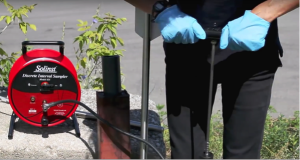
3) The applied pressure forces the bottom check ball closed, which prevents water from entering the pump while it is being lowered. The hand pump is disconnected from the reel, and the DIS is slowly lowered to the desired sampling depth.
Note: A cable connector is included at the top of the DIS for easy attachment to a suspension cable or Model 103 Tag Line.
4) To obtain a grab sample, the valve on the reel is switched to “Vent”, and pressure is released from the DIS. The bottom check ball releases, allowing hydrostatic pressure to fill the DIS. The sample water forces the top check ball closed, which prevents the sample water from entering the tubing. It takes about 1 – 3 minutes for the DIS to fill.
5) When it is time to retrieve the sample, the hand pump is reconnected to the reel and the valve is switched back to Pressurize. The same amount of pressure is re-applied. Pressure closes the bottom check ball. This prevents the sample water from exiting the pump during retrieval, ensuring the sample chemistry remains intact.
6) At the surface, the valve is switched to Vent and the bottom check ball releases. The Sample Release Device is used to unseat the bottom check ball and collect the sample. It is designed to regulate flow and minimize degassing of the sample.
Still need a better picture of how the DIS works? In addition to the Operating Instructions and Operating Principles documents, Solinst has produced a video that walks you through all the steps of DIS operation, from determining your sampling depth and setting up the equipment, to deployment and groundwater sample collection.
Note: Solinst now offers the Model 425-D Deep Sampling Discrete Interval Sampler, which allows sampling from submerged depths as much as 1200 m (4000 ft)! Its operation is based on the basic Principles of Hydraulics, and you can read more about this in the Model 425 Discrete Interval Samplers data sheet.
Why use a Discrete Interval Sampler?
The DIS shares the advantages of most no purge or passive samplers, including low costs, minimal labour, no power requirements, no compressor or control unit needed, and little agitation created in the well. The DIS has additional advantages:
- Sample is never pumped through tubing
- Sample is never mixed with water from different levels in the well or open hole
- Easy to disassemble and decontaminate
- Easy to operate and transport
- Effective for collecting groundwater samples with any type of chemical constituents
A major advantage of the DIS is the narrow depth range within the well or borehole that the DIS obtains a sample from. Its design causes no movement during sampling. This makes the DIS ideal for sampling from specific points of inflow, or thin product layers, including DNAPLs or LNAPLs.
The stainless steel DIS is excellent for sampling all analytes, including sampling for Volatile Organic Compounds (VOCs). This is because the sample does not mix with water from different intervals, and does not travel through a long length of tubing, risking loss of volatiles. The sample has minimal contact with air, even as the sample is collected. The Sample release device is designed to minimize any offgassing.
The Discrete Interval Sampler is included in a table (first row) presented on the CLU-IN website, which provides a summary of the common analytes that can be sampled using various no purge samplers. The DIS is listed as able to sample for them all, including VOCs, as well as metals, anions, and MTBE.
As studies and projects increasingly illustrate the advantages and value of using no purge techniques, they continue to be a more widely accepted method for obtaining representative groundwater samples. With that in mind, why not try a Discrete Interval Sampler for your next project? Contact us for a free quote today!
References
ITRC (Interstate Technology & Regulatory Council). 2007. Protocol for Use of Five Passive Samplers to Sample for a Variety of Contaminants in Groundwater. DSP-5. Washington, D.C.: Interstate Technology & Regulatory Council, Diffusion/Passive Sampler Team. http://www.itrcweb.org
Parker, Louise V., Charles H. Clark. 2002. Study of Five Discrete Interval-Type Groundwater Sampling Devices. US Army Corps of Engineers® Engineer Research and Development Center, Technical Report: ERDC/CRREL TR-02-12.
CLU-IN (Contaminated Site Clean-Up Information). 2016. Passive (no purge) Samplers. United States Environmental Protection Agency, Technology Innovation and Field Services Division. https://clu-in.org/characterization/technologies/default.focus/sec/Passive_%28no%20purge%29_Samplers/cat/Overview/


